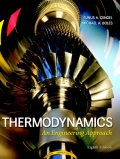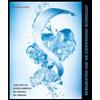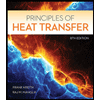
EBK THERMODYNAMICS: AN ENGINEERING APPR
8th Edition
ISBN: 8220100257056
Author: CENGEL
Publisher: YUZU
expand_more
expand_more
format_list_bulleted
Concept explainers
Textbook Question
Chapter 5.5, Problem 196FEP
An adiabatic heat exchanger is used to heat cold water at 15°C entering at a rate of 5 kg/s with hot water at 90°C entering at a rate of 4 kg/s. If the exit temperature of hot water is 50°C, the exit temperature of cold water is
- (a) 42°C
- (b) 47°C
- (c) 55°C
- (d) 78°C
- (e) 90°C
Expert Solution & Answer
Want to see the full answer?
Check out a sample textbook solution
Students have asked these similar questions
3
Water at 15°C ( p = 999.1 kg/m³ and µ = 1.138 × 10¯³kg/m.s) is flowing
steadily in a 34-m-long and 6-cm-diameter horizontal pipe made of stainless
steel at a rate of 10 L/s. Determine the pressure drop, the head loss, and the
pumping power requirement to overcome this pressure drop. The roughness
of stainless steel is 0.002 mm.
10 L/s
6 cm
L
The pressure drop is 34.77
kPa.
The head loss is 3.55 m. (Round the final answer to two decimal places.)
The pumping power requirement is 0.348 kW. (Round the final answer to
three decimal places.)
6
10
ints awarded
Scored
Gasoline ( p = 680 kg/m³ and v = 4.29 × 107 m²/s) is transported at a
rate of 240 L/s for a distance of 2 kilometre. The surface roughness of the
piping is 0.03 mm. If the head loss due to pipe friction is not to exceed 14 m,
determine the minimum diameter of the pipe using the third Swamee-Jain
formula. (Round the final answer to three decimal places.)
The minimum diameter of the pipe is 0.443
m.
1
Water at 15°C ( p = 999.1 kg/m³ and µ = 1.138 × 10¯¯³kg/m.s) is flowing
steadily in a 34-m-long and 6-cm-diameter horizontal pipe made of stainless
steel at a rate of 10 L/s. Determine the pressure drop, the head loss, and the
pumping power requirement to overcome this pressure drop. The roughness
of stainless steel is 0.002 mm.
eBook
Hint
10 L/s
6 cm
L
The pressure drop is
The head loss is
kPa.
|m. (Round the final answer to two decimal places.)
The pumping power requirement is
three decimal places.)
kW. (Round the final answer to
Chapter 5 Solutions
EBK THERMODYNAMICS: AN ENGINEERING APPR
Ch. 5.5 - Prob. 1PCh. 5.5 - Define mass and volume flow rates. How are they...Ch. 5.5 - Does the amount of mass entering a control volume...Ch. 5.5 - Consider a device with one inlet and one outlet....Ch. 5.5 - The ventilating fan of the bathroom of a building...Ch. 5.5 - 5–6E Air whose density is 0.078 lbm/ft3 enters the...Ch. 5.5 - 5–7 Air enters a 28-cm diameter pipe steadily at...Ch. 5.5 - A steady-flow compressor is used to compress...Ch. 5.5 - A 2-m3 rigid tank initially contains air whose...Ch. 5.5 - 5–10 A cyclone separator like that in Fig. P5–10...
Ch. 5.5 - 5–11 A spherical hot-air balloon is initially...Ch. 5.5 - A desktop computer is to be cooled by a fan whose...Ch. 5.5 - 5–13 A pump increases the water pressure from 100...Ch. 5.5 - Refrigerant-134a enters a 28-cm-diameter pipe...Ch. 5.5 - Prob. 15PCh. 5.5 - Prob. 16PCh. 5.5 - 5–17C What is flow energy? Do fluids at rest...Ch. 5.5 - How do the energies of a flowing fluid and a fluid...Ch. 5.5 - Prob. 19PCh. 5.5 - Prob. 20PCh. 5.5 - Refrigerant-134a enters the compressor of a...Ch. 5.5 - Steam is leaving a pressure cooker whose operating...Ch. 5.5 - A diffuser is an adiabatic device that decreases...Ch. 5.5 - The kinetic energy of a fluid increases as it is...Ch. 5.5 - Prob. 25PCh. 5.5 - Air enters a nozzle steadily at 50 psia, 140F, and...Ch. 5.5 - The stators in a gas turbine are designed to...Ch. 5.5 - The diffuser in a jet engine is designed to...Ch. 5.5 - Air at 600 kPa and 500 K enters an adiabatic...Ch. 5.5 - Prob. 30PCh. 5.5 - Prob. 31PCh. 5.5 - Air at 13 psia and 65F enters an adiabatic...Ch. 5.5 - Carbon dioxide enters an adiabatic nozzle steadily...Ch. 5.5 - Refrigerant-134a at 700 kPa and 120C enters an...Ch. 5.5 - Prob. 35PCh. 5.5 - Refrigerant-134a enters a diffuser steadily as...Ch. 5.5 - Prob. 38PCh. 5.5 - Air at 80 kPa, 27C, and 220 m/s enters a diffuser...Ch. 5.5 - 5–40C Consider an air compressor operating...Ch. 5.5 - Prob. 41PCh. 5.5 - Somebody proposes the following system to cool a...Ch. 5.5 - 5–43E Air flows steadily through an adiabatic...Ch. 5.5 - Prob. 44PCh. 5.5 - Prob. 45PCh. 5.5 - Steam flows steadily through an adiabatic turbine....Ch. 5.5 - Prob. 48PCh. 5.5 - Steam flows steadily through a turbine at a rate...Ch. 5.5 - Prob. 50PCh. 5.5 - Carbon dioxide enters an adiabatic compressor at...Ch. 5.5 - Prob. 52PCh. 5.5 - 5–54 An adiabatic gas turbine expands air at 1300...Ch. 5.5 - Prob. 55PCh. 5.5 - Prob. 56PCh. 5.5 - Air enters the compressor of a gas-turbine plant...Ch. 5.5 - Why are throttling devices commonly used in...Ch. 5.5 - Would you expect the temperature of air to drop as...Ch. 5.5 - Prob. 60PCh. 5.5 - During a throttling process, the temperature of a...Ch. 5.5 - Refrigerant-134a is throttled from the saturated...Ch. 5.5 - A saturated liquidvapor mixture of water, called...Ch. 5.5 - Prob. 64PCh. 5.5 - A well-insulated valve is used to throttle steam...Ch. 5.5 - Refrigerant-134a enters the expansion valve of a...Ch. 5.5 - Prob. 68PCh. 5.5 - Consider a steady-flow heat exchanger involving...Ch. 5.5 - Prob. 70PCh. 5.5 - Prob. 71PCh. 5.5 - Prob. 72PCh. 5.5 - Prob. 73PCh. 5.5 - Prob. 74PCh. 5.5 - Prob. 76PCh. 5.5 - Steam is to be condensed on the shell side of a...Ch. 5.5 - Prob. 78PCh. 5.5 - Air (cp = 1.005 kJ/kgC) is to be preheated by hot...Ch. 5.5 - Prob. 80PCh. 5.5 - Refrigerant-134a at 1 MPa and 90C is to be cooled...Ch. 5.5 - Prob. 82PCh. 5.5 - An air-conditioning system involves the mixing of...Ch. 5.5 - The evaporator of a refrigeration cycle is...Ch. 5.5 - Steam is to be condensed in the condenser of a...Ch. 5.5 - Steam is to be condensed in the condenser of a...Ch. 5.5 - Two mass streams of the same ideal gas are mixed...Ch. 5.5 - Prob. 89PCh. 5.5 - A 110-volt electrical heater is used to warm 0.3...Ch. 5.5 - The fan on a personal computer draws 0.3 ft3/s of...Ch. 5.5 - Prob. 92PCh. 5.5 - 5–93 A scaled electronic box is to be cooled by...Ch. 5.5 - Prob. 94PCh. 5.5 - Prob. 95PCh. 5.5 - Prob. 96PCh. 5.5 - Prob. 97PCh. 5.5 - A computer cooled by a fan contains eight PCBs,...Ch. 5.5 - Prob. 99PCh. 5.5 - A long roll of 2-m-wide and 0.5-cm-thick 1-Mn...Ch. 5.5 - Prob. 101PCh. 5.5 - Prob. 102PCh. 5.5 - A house has an electric heating system that...Ch. 5.5 - Steam enters a long, horizontal pipe with an inlet...Ch. 5.5 - Refrigerant-134a enters the condenser of a...Ch. 5.5 - Prob. 106PCh. 5.5 - Water is heated in an insulated, constant-diameter...Ch. 5.5 - Prob. 108PCh. 5.5 - Air enters the duct of an air-conditioning system...Ch. 5.5 - A rigid, insulated tank that is initially...Ch. 5.5 - 5–113 A rigid, insulated tank that is initially...Ch. 5.5 - Prob. 114PCh. 5.5 - A 0.2-m3 rigid tank equipped with a pressure...Ch. 5.5 - Prob. 116PCh. 5.5 - Prob. 117PCh. 5.5 - Prob. 118PCh. 5.5 - Prob. 119PCh. 5.5 - An air-conditioning system is to be filled from a...Ch. 5.5 - Oxygen is supplied to a medical facility from ten...Ch. 5.5 - Prob. 122PCh. 5.5 - A 0.3-m3 rigid tank is filled with saturated...Ch. 5.5 - Prob. 124PCh. 5.5 - Prob. 125PCh. 5.5 - Prob. 126PCh. 5.5 - The air-release flap on a hot-air balloon is used...Ch. 5.5 - An insulated 0.15-m3 tank contains helium at 3 MPa...Ch. 5.5 - An insulated 40-ft3 rigid tank contains air at 50...Ch. 5.5 - A vertical pistoncylinder device initially...Ch. 5.5 - A vertical piston-cylinder device initially...Ch. 5.5 - Prob. 135RPCh. 5.5 - Prob. 136RPCh. 5.5 - Air at 4.18 kg/m3 enters a nozzle that has an...Ch. 5.5 - An air compressor compresses 15 L/s of air at 120...Ch. 5.5 - 5–139 Saturated refrigerant-134a vapor at 34°C is...Ch. 5.5 - A steam turbine operates with 1.6 MPa and 350C...Ch. 5.5 - Prob. 141RPCh. 5.5 - Prob. 142RPCh. 5.5 - Prob. 143RPCh. 5.5 - Steam enters a nozzle with a low velocity at 150C...Ch. 5.5 - Prob. 146RPCh. 5.5 - Prob. 147RPCh. 5.5 - Prob. 148RPCh. 5.5 - Prob. 149RPCh. 5.5 - Cold water enters a steam generator at 20C and...Ch. 5.5 - Prob. 151RPCh. 5.5 - An ideal gas expands in an adiabatic turbine from...Ch. 5.5 - Prob. 153RPCh. 5.5 - Prob. 154RPCh. 5.5 - Prob. 155RPCh. 5.5 - Prob. 156RPCh. 5.5 - Prob. 157RPCh. 5.5 - Prob. 158RPCh. 5.5 - Prob. 159RPCh. 5.5 - Prob. 160RPCh. 5.5 - Prob. 161RPCh. 5.5 - Prob. 162RPCh. 5.5 - Prob. 163RPCh. 5.5 - The ventilating fan of the bathroom of a building...Ch. 5.5 - Determine the rate of sensible heat loss from a...Ch. 5.5 - An air-conditioning system requires airflow at the...Ch. 5.5 - The maximum flow rate of standard shower heads is...Ch. 5.5 - An adiabatic air compressor is to be powered by a...Ch. 5.5 - Prob. 171RPCh. 5.5 - Prob. 172RPCh. 5.5 - Prob. 173RPCh. 5.5 - Prob. 174RPCh. 5.5 - Prob. 175RPCh. 5.5 - A tank with an internal volume of 1 m3 contains...Ch. 5.5 - A liquid R-134a bottle has an internal volume of...Ch. 5.5 - Prob. 179RPCh. 5.5 - Prob. 181RPCh. 5.5 - Prob. 182RPCh. 5.5 - Prob. 184RPCh. 5.5 - A pistoncylinder device initially contains 1.2 kg...Ch. 5.5 - In a single-flash geothermal power plant,...Ch. 5.5 - The turbocharger of an internal combustion engine...Ch. 5.5 - A building with an internal volume of 400 m3 is to...Ch. 5.5 - Prob. 189RPCh. 5.5 - Prob. 190RPCh. 5.5 - Prob. 191RPCh. 5.5 - Prob. 192FEPCh. 5.5 - Prob. 193FEPCh. 5.5 - An adiabatic heat exchanger is used to heat cold...Ch. 5.5 - A heat exchanger is used to heat cold water at 15C...Ch. 5.5 - An adiabatic heat exchanger is used to heat cold...Ch. 5.5 - In a shower, cold water at 10C flowing at a rate...Ch. 5.5 - Prob. 198FEPCh. 5.5 - Hot combustion gases (assumed to have the...Ch. 5.5 - Steam expands in a turbine from 4 MPa and 500C to...Ch. 5.5 - Steam is compressed by an adiabatic compressor...Ch. 5.5 - Refrigerant-134a is compressed by a compressor...Ch. 5.5 - Prob. 203FEPCh. 5.5 - Prob. 204FEPCh. 5.5 - Air at 27C and 5 atm is throttled by a valve to 1...Ch. 5.5 - Steam at 1 MPa and 300C is throttled adiabatically...Ch. 5.5 - Air is to be heated steadily by an 8-kW electric...
Knowledge Booster
Learn more about
Need a deep-dive on the concept behind this application? Look no further. Learn more about this topic, mechanical-engineering and related others by exploring similar questions and additional content below.Similar questions
- 3 eBook Hint Air enters an 15-m-long section of a rectangular duct of cross section 15 cm x 20 cm made of commercial steel at 1 atm and 35°C at an average speed of 5 m/s. Disregarding the entrance effects, determine the fan power needed to overcome the pressure losses in this section of the duct. The properties of air at 1 atm and 35°C are p = 1.145 kg/m³, µ = 1.895 × 10−5 kg/m·s, and v = 1.655 × 10¯5m²/s. The roughness of commercial steel surfaces is = 0.000045 m. (Round the final answer to three decimal places.) L 15 cm Air 20 cm 5 m/s The fan power needed to overcome the pressure losses is 4.0695 W.arrow_forward12) A particle is moving along a circular path having a radius of 6 in. such that its position as a function of time is given by 0 = sin 3t, where 0 is in radians, the argument for the sine are in radians, and t is in seconds. Determine the acceleration of the particle at 0 = 30°. The particle starts from rest at 0 = 0°.arrow_forward6) == The particle travels along the path defined by the parabola y 0.5x2. If the component of velocity along the x axis is Vx = (5t) ft/s, where t is in seconds, determine the particle's distance from the origin O and the magnitude of its acceleration when t = 1s. When t 0, x = 0, y = 0. =arrow_forward
- 7) Determine the minimum initial velocity vo and the corresponding angle 00 at which the ball must be kicked in order for it to just cross over the 3-m high fence. VO θα 6 m 3 marrow_forward11) = If a particle moves along a path such that r = (2 cost) ft and (t/2) rad, where t is in seconds, plot the path r = f(0) and determine the particle's radial and transverse components of velocity and acceleration.arrow_forward9) The car travels around the circular track having a radius of r = 300 m such that when it is at point A it has a velocity of 5 m/s, which is increasing at the rate of v = (0.06t) m/s², where t is in seconds. Determine the magnitudes of its velocity and acceleration when it has traveled one-third the way around the track.arrow_forward
- 15) Two boats leave the pier P at the same time and travel in the directions shown. If v = 40 ft/s and vB = 30 ft/s, VA determine the velocity of boat A relative to boat B. How long after leaving the pier will the boats be 1500 ft apart? =40 ft/s UB=30 ft/s 30° 45°arrow_forward14) Determine the time needed for the load at B to attain a speed of 10 m/s, starting from rest, if the cable is drawn into the motor with an acceleration of 3 m/s². C Barrow_forward13) Starting from rest, the cable can be wound onto the drum of the motor at a rate of v₁ = (31²) m/s, where t is in seconds. Determine the time needed to lift the load 7 m. 40 D A C Barrow_forward
- 13) Starting from rest, the cable can be wound onto the drum of the motor at a rate of v₁ = (31²) m/s, where t is in seconds. Determine the time needed to lift the load 7 m.arrow_forward10) At a given instant the train engine at E has a speed of 20 m/s and an acceleration of 14 m/s² acting in the direction shown. Determine the rate of increase in the train's speed and the radius of curvature p of the path. Ans. a 14 m/s² E v = 20 m/sarrow_forward8) The satellite S travels around the earth in a circular path with a constant speed of 20 Mm/h. If the acceleration is 2.5 m/s², determine the altitude h. Assume the earth's diameter to be 12 713 km.arrow_forward
arrow_back_ios
SEE MORE QUESTIONS
arrow_forward_ios
Recommended textbooks for you
 Refrigeration and Air Conditioning Technology (Mi...Mechanical EngineeringISBN:9781305578296Author:John Tomczyk, Eugene Silberstein, Bill Whitman, Bill JohnsonPublisher:Cengage Learning
Refrigeration and Air Conditioning Technology (Mi...Mechanical EngineeringISBN:9781305578296Author:John Tomczyk, Eugene Silberstein, Bill Whitman, Bill JohnsonPublisher:Cengage Learning Principles of Heat Transfer (Activate Learning wi...Mechanical EngineeringISBN:9781305387102Author:Kreith, Frank; Manglik, Raj M.Publisher:Cengage Learning
Principles of Heat Transfer (Activate Learning wi...Mechanical EngineeringISBN:9781305387102Author:Kreith, Frank; Manglik, Raj M.Publisher:Cengage Learning

Refrigeration and Air Conditioning Technology (Mi...
Mechanical Engineering
ISBN:9781305578296
Author:John Tomczyk, Eugene Silberstein, Bill Whitman, Bill Johnson
Publisher:Cengage Learning

Principles of Heat Transfer (Activate Learning wi...
Mechanical Engineering
ISBN:9781305387102
Author:Kreith, Frank; Manglik, Raj M.
Publisher:Cengage Learning
How Shell and Tube Heat Exchangers Work (Engineering); Author: saVRee;https://www.youtube.com/watch?v=OyQ3SaU4KKU;License: Standard Youtube License